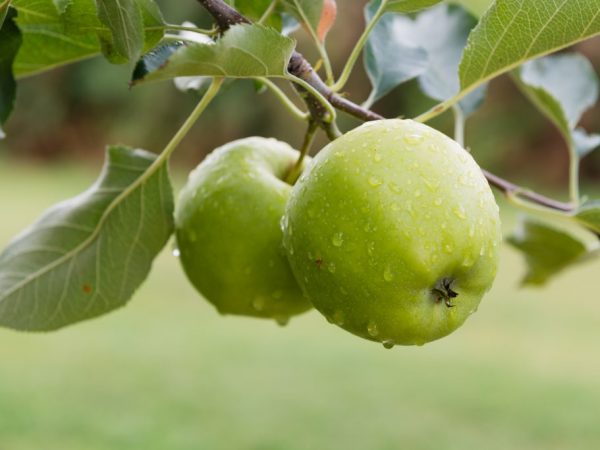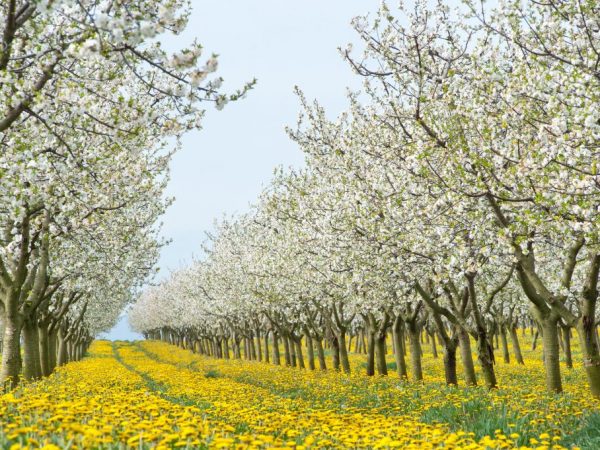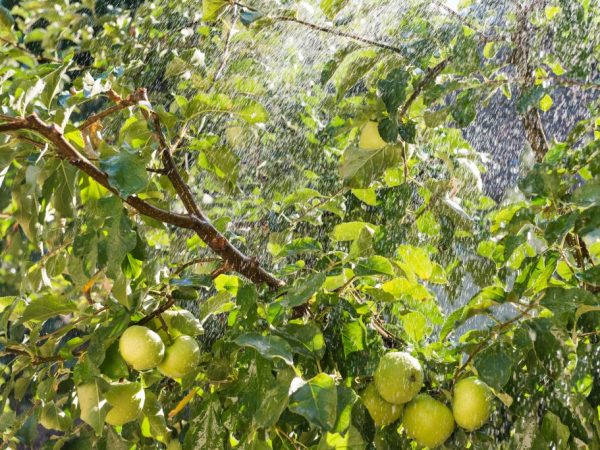Varietal features of the Russian apple tree
The Russian apple tree is the result of crossing two popular varieties - Babushkino and Antonovka. The hybrid combines their positive qualities: it is frost-resistant and immune to various garden diseases. The apple tree grows quickly and gives a stable harvest. Culture takes root in the central regions of the country.

Varietal features of the Russian apple tree
Description
This variety is a late winter variety. The hybrid is resistant to cold weather - this was the main goal when crossing the two popular varieties. Also, this species is characterized by increased resistance to scab.
General characteristics of the hybrid:
- the culture bears fruit not earlier than the 6th year;
- gives a large annual harvest - even in the most unfavorable conditions, the apple tree bears fruit;
- the variety is highly immune.
This apple tree can pollinate on its own. She does not need a favorable neighborhood, but cross-pollination can improve the quality indicators of the future harvest.
The varieties that will participate in the pollination process are selected according to characteristics common to the Russian woman - the period of fruiting and the size of the fruits. Other species go well with winter culture: they allow you to increase the size of apples.
Fruit characteristics
The fruits of the Russian apple tree are medium. The variety does not differ in a large increase in the mass of fruits, even in correctly created conditions. The maximum weight of one apple is 140 g. The average fruit is not more than 120 g. The minimum weight is 100 g.
The fruit has a round shape and smooth skin. The apples are round but conical. The species has no cover color. The base color is yellow, more intense before ripening. Unripe fruits are bright green in color.
The color of the funnel is different - it is bright orange. The apple tree owes such a feature to the Antonovka variety - to its "relative". Apples have a light flesh. The taste of the fruit is characteristic, with sourness, but it is not pronounced.
The variety is famous for its balanced composition. One fruit contains a large amount of sugar and ascorbic acid. There are at least 35 mg of nutrients in one apple.
Fruits ripen after harvest. On the tree, the fruits do not reach their characteristic color and delicate taste. They are removed prematurely and only then brought to the desired state in the right conditions. From the moment of harvest, at least a month passes before the appearance of a yellow skin.
The first sign that the apples are ripe is that they start to exude a strong, spicy aroma. Fruits are stored until the end of spring and do not lose their presentation.
Description of the tree
The apple tree of the variety is not large in size. The crown grows moderately during the first few years. At the same time, if the gardener plans to create a beautiful crown, a mandatory pruning is carried out. The crown is dense, because the foliage on the branches grows a lot.
The Rossiyanka tree has the following features:
- average high-rise culture - 5 m: trees up to 4 m grow only in cramped conditions;
- a compact tree is formed from the variety by proper pruning - its height does not exceed 3.5 m, pruning does not affect the quality of the fruit;
- the annual growth is 50-60 cm: too little or too much growth is not a good trend;
- deciduous plate is wide, green;
- the surface of the foliage is slightly pubescent;
- the branches are covered with maroon bark, and the trunk is dark brown;
- branches are evenly spaced, departing at right angles from the trunk.
Thanks to a good immune system, the tree does not suffer from common diseases of horticultural crops. It does not get sick with scab or powdery mildew.
Advantages and disadvantages

The variety tolerates lower temperatures
The variety stands out for its winter hardiness. Sudden changes in temperature or prolonged winter are not terrible for culture. Such high rates are determined not only by the characteristics of the variety itself, but also by proper care. If the tree is not insulated for the winter, it may suffer.
High immunity is another plus of the variety. If trees begin to ache in the garden, then in most cases this species will remain unharmed.
The high yield is also one of the advantages of the variety. The number of apples is increasing every year. They are densely located on the branches: shoots can bend under load, but rarely break. This is another advantage of the variety.
Fruit is stored for a long period and does not spoil. The advantages of the variety include good transportability. Apples are on sale and retain their attractive appearance for a long period.
There are few disadvantages of the variety. Delicious apples can be eaten raw, but only after they have stood. They are very sour and inedible immediately after harvest. Fruits are used for making juices and jams: but in this case, you will have to wait until the harvested crop reaches the desired state.
Disembarkation
The variety is planted according to the standard scheme. For this, a young tree is selected, a planting pit is dug and fertilized. After sowing, after 2-3 weeks, regular maintenance is established. This sequence will allow you to plant a tree and get the first harvest after a few years.
The number of apples depends on which planting material will be chosen:
- two-year-old seedlings of the variety are selected - they are more resistant, therefore they are suitable even for late autumn planting;
- two-year-olds have small shoots - this is their main distinguishing feature - a hint for the gardener;
- the rhizome of the appendix is checked - it should bend well, but not break;
- if the roots come off, it is impossible to take such a seedling - an incorrect grafting of the material was carried out;
- the roots should remain moderately moist;
- a rich green hue should be visible under the bark;
- you cannot take a sapling on which leaves have already formed.
After choosing the planting material, a suitable land plot is selected. The Russian apple variety needs space, so small areas are not suitable. The variety has no requirements for soil. If it is too sandy, a little clay is applied, and if it is clay, the soil is diluted with several buckets of sand before planting.
They do not choose lowlands for planting, so that the rhizome of the culture is not constantly heated. There should be a lot of sunlight on the site. The apple tree loves warmth, especially during the period of fruit formation.
An important characteristic for the selection of a suitable place is the height of the groundwater. This figure must be at least 3 meters.
Timing
Like any other variety, the Russian woman is planted twice a year. In the spring, even an annual crop is sown: it manages to take root during the warm summer period.
The end of April and the beginning of May are the most optimal periods for such work.On neighboring crops, buds have not yet formed, and the soil layer has already warmed up after winter. In the absence of these conditions, landing is not worth it. For the spring procedure, the planting pit is prepared in the fall.
The second type of planting is autumn. It is more complex, and only two-year planting material is used for these purposes. The favorable period falls in mid-December. It is important that at least a month pass from the moment of planting to the onset of frost. Until spring, the seedling is insulated, and then a strong root system has time to form by the arrival of heat.
Scheme and technology

Trees should not interfere with each other
For planting an apple tree, a special scheme is used. It guarantees the correct growth of the tree without harming neighboring crops. The area of the land plot is selected from the following proportion: length 4 m and width 3 m. The estimated space is taken for an adult tree.
After the preparation of the seedling and the choice of the land plot, the decisive moment comes - the preparation of the planting pit. It provides the seed with nourishment and protection.
In order not to lose the culture, the preparation of the pit begins 2 weeks before the moment of disembarkation. A hole is dug with a depth of 70 cm. Its diameter should be at least 50 cm. The finished hole is fertilized.
Top dressing is compost, slurry or any other safe organic matter. It is applied in a thick layer - at least 5 cm, therefore it is diluted with water or decayed leaves. After fertilization, a week passes, and the topsoil is mixed with the remains of organic fertilizing. The pit is left for another week.
On the day of disembarkation, a drainage system is installed. It is needed only when the site is located in a lowland or groundwater is located very high. Drainage ensures proper circulation of water at the root system - it does not rot, but does not dry out either. After that, the count is set. It will serve as a solid foundation for the seedling.
The seedling is immersed in the pit, and its roots are immediately leveled. Fresh soil is poured on top and carefully compacted. To protect the crop, a roller is laid around the root part: it is created from the remains of the soil. This will keep moisture in after watering.
After being placed in the ground, the seedling is watered abundantly. This will require 4 buckets of heated water. The next watering occurs no earlier than a week later.
Care rules
An unpretentious variety grows better and bears more fruit if proper care is established. This requires regular watering, fertilizing the soil and trimming excess branches.
Additionally, you can carry out the following events:
- loosening the soil - a procedure before watering or fertilizing: the throughput of the soil increases;
- weeding of a land plot - any weeds draw out excess moisture from the soil, and the rhizome of the apple tree dries up;
- spraying a tree is a prophylaxis that is carried out simultaneously on all horticultural crops.
Proper care affects the quality of apples, the speed of their ripening and composition.
Irrigation works
An apple tree of this variety requires at least 4 waterings per season.
A certain irrigation rate is established - it cannot be changed even in summer. The tree learns self-regulation and moisture distribution. More water is added during flowering and fruit formation. Moisturizing is combined with fertilization - replenishment is faster and more intense.
The average moisture impregnation for a tree is 10 cm. If the soil is dry, the tree grows poorly, but still bears fruit - the fruits are tasteless and sour. Only the addition of liquid will change the situation.
Drip irrigation is preferred. It allows moisture to be distributed throughout the crop. It is impossible to fill the rhizome with a large amount of water. Due to such actions of the gardener, soil erosion will occur.
An alternative option is hole watering. For this, a small depression is created around the tree, into which most of the liquid is introduced.Spraying with water with nutrients is useful in summer, but only after sunset so that the leaves do not burn.
Regular feeding

The tree needs to be fertilized regularly
For crop safety, fertilizers are applied at a distance of 60 cm from the root part.
The distance maintained will allow the soil to be nourished without harming the apple tree. Without fail, this rule is observed for seedlings. Mineral fertilizers and organic matter are used for feeding.
Organic fertilizers include compost, bird droppings and manure. Top dressing is preliminarily settled and diluted with water to reduce the concentration of active components. It is brought in no more than 3 times a year. Suitable for spring and summer make-up.
The best mineral fertilizers for the variety are potassium, phosphorus, nitrogen and complex baits, which combine several nutritional components at once.
Local fertilizers that are applied to the upper layers of the soil during the period of active tree growth and fruit formation include compost flour, ash, lime and sapropel. Such substances are used no more than 3 times a year and only during the warm period. Safe components can be added during maintenance work.
Non-traditional fertilizers include phosphogypsum and shale ash. They are used once a year after all horticultural crops have suffered one disease. Fertilizer is applied to the entire land plot.
Crown pruning
There are two types of pruning - mandatory sanitary and additional shaping.
In spring, the shape of the crown is created. This is a "cosmetological" procedure for an apple tree. Extra branches, broken and crooked shoots are cut off. The crown is thinned out, which favorably affects the entire process of fruit formation. Leave only smooth and full-fledged branches.
Autumn pruning is called sanitary, because it is used to clean the tree. Broken or diseased twigs are removed. If the spring procedure is carried out before the appearance of the buds, then in the fall you need to harvest the crop, and only then pruning.
The cut sites are cleaned and treated with special solutions. After that, insulation is carried out for the winter.
Winter care
For the winter, the apple tree is insulated. For this, hay flooring is used. A mulching system is suitable. In this case, the root system is protected from frost, and the trunk is protected from pests. The branches are covered with nets to prevent rodent attacks.
After the appearance of precipitation, additional procedures are not carried out. The snow layer will provide additional protection for the tree. With the arrival of spring, standard care resumes: watering begins and the soil is fertilized.
Fruiting and harvest time
Fruiting of the variety is average. The first fruits are formed in the 5th or 6th year.
The beginning of fruiting depends on the temperature regime of the region where the apple tree grows. The colder it is, the later this process begins. After the appearance of the first fruits, their number increases annually.
This apple tree is a late variety. For this reason, flowering occurs later than in other crops. By mid-June, the apple tree blooms completely. Fruit ripening is also delayed.

Flowering and fruiting of an apple tree depends on weather conditions
The late fruiting date of the apple tree The Russian woman determines the collection of her harvest. Already in the fall, green apples are cut off so that they ripen at home. For harvesting, it is better to focus on dates.
The fruits will remain green, and it is impossible to understand from their condition when they need to be removed. Until the beginning of October, all fruits are harvested from the branches. After that, at least a month passes before the harvest is ready.
Storage
This species is famous for the period of its storage. Even against the background of winter varieties, apples are stored longer than usual.
This feature is due to the chemical composition of the fruit and the structure of the skin. The first month after harvest, the apples are still ripe.During this time, they are stored indoors in the sun or even outdoors. It is important that there is no high humidity.
After that, the fruits are transferred to another storage system. Boxes with apples are placed in a cold, semi-dark room. The fruits are stored separately from other types, and the rotten or damaged product is immediately thrown away.
Growing regions
A variety is selected for the weather conditions. Atypical climate change is offset by care, but basic temperature or humidity readings will be a permanent negative factor. For this reason, the variety is grown only in the territory:
- Siberia. In this region, there are often severe frosts and most of the apple varieties cannot tolerate them. The Russian woman quickly takes root and bears fruit regularly. Freezing can occur, but only in a mild form. After that, the apple tree quickly recovers;
- Leningrad region. This area is distinguished by strong winds. It is impossible to protect land plots from them. This variety is characterized by increased wind resistance;
- Moscow region. This species quickly takes root. It tolerates severe frosts and grows actively with the arrival of heat. Spring temperature drops do not threaten the apple tree.
Gardeners reviews
The Russian apple tree can be attributed to varieties that can be grown on any plot of land.
Therefore, experienced gardeners recommend taking a closer look at it. It is especially beneficial to plant a tree in the north of the country, where winter frosts kill most crops. The apple tree not only withstands temperature extremes, but also quickly recovers by the spring.
According to gardeners, the variety is immune to disease, which reduces the likelihood of contamination of neighboring crops. Even if you do not carry out constant prevention, the apple tree will survive.
The stability of the crop every year is the main advantage of the species, for which experienced gardeners and beginners choose it. Over the years, the amount of the crop increases, and it can be easily stored for several months.

